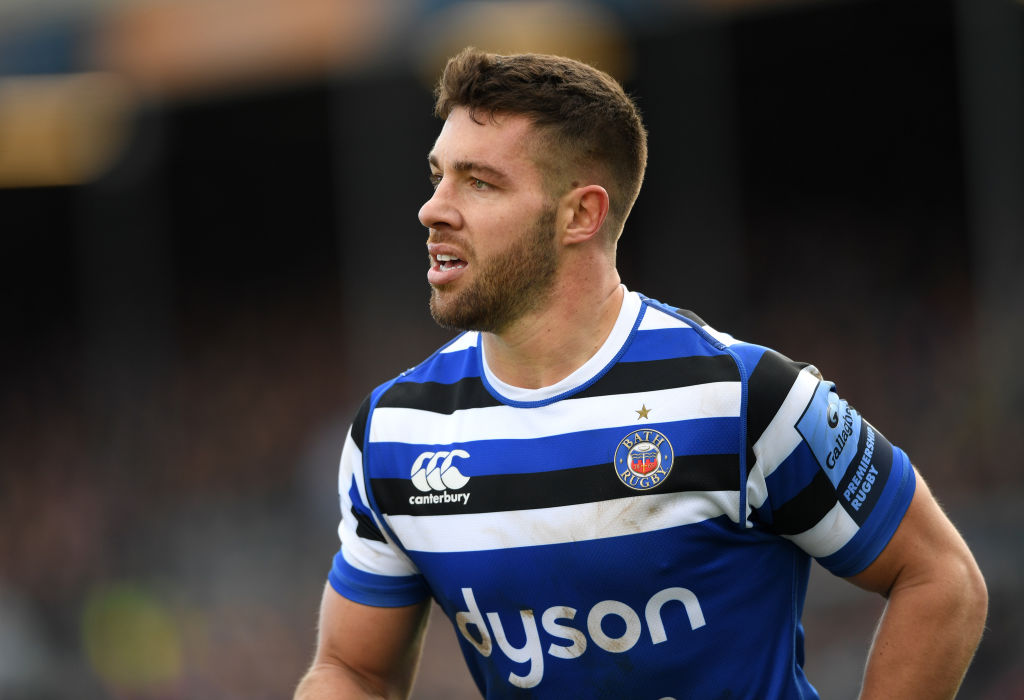Guscott column: Bath need a 9-10 combination which gives them quick ball

BATH, ENGLAND - MARCH 01: Bath scrum half Rhys Webb looks on during the Gallagher Premiership Rugby match between Bath Rugby and Bristol Bears at The Recreation Ground on March 01, 2020 in Bath, England. (Photo by Stu Forster/Getty Images)
BATH fans will be pleased by the announcement from director of rugby Stuart Hooper that he wants to play more attacking rugby, and score more tries.
However, creating an attacking style does not happen overnight, especially as what we have seen in the season before the suspension is a Bath pack that’s been going reasonably well, but a backline that has been not so hot.
These days, attacking patterns are more integrated in attack with forwards and backs required to link together, and sometimes, when the pressure is on, Bath’s handling does not hold up.
As a consequence, I don’t like watching Bath handling in their own half. They are not overly-confident when they do it, and there are often costly mistakes, so at the moment it’s a case of the simpler the better – which means that to begin with, they should attack when they are in the opposition half.
There is a series of events that has to happen for a team to attack well, and it doesn’t matter whether it is from line-out, scrum, breakdown or kicking. It requires a team to be clever, smart and inventive rather than focusing purely on defence and power in contact.
The fundamental in attack is quick ball, because otherwise you are dependent on opposition mistakes in defence, or X-factor moments of individual excellence such as those if you are lucky enough to have a Semi Radrada, Cheslin Kolbe, Billy Vunipola, Manu Tuilagi – or the Bath equivalent, Anthony Watson and Joe Cokanasiga.
However, no team can place too much reliance on those moments of brilliance, which is why quick ball is so important. If you have it, you are singing and dancing – it is the oxygen of attack.
The first requirement is a good pack in which the majority are very good ball carriers. It doesn’t matter whether they run through weak arms, over the top of defenders, or round them, or through gaps, they have to produce quick ball.
You can see the importance when you look at Saracens, because while a backline of Richard Wigglesworth, Owen Farrell, Brad Barritt, Marcelo Bosch and Alex Goode is very good, and has the experience to make the most of quick ball, it is not the most scary in terms of pace.
The reason that backline scored so many tries on the way to becoming the best club team in the world is because the Saracens pack is so dominant it has made them look world-class. Just imagine what Saracens would have been like if they had the Fiji 2019 World Cup backline outside that pack!
The Bath pack this season has performed solidly, but overall during the last eight seasons they have been pretty ordinary. The only exception was in 2014-15 when they were competitive and had a truly interchangeable front five.
That season they had George Ford, Jonathan Joseph and Watson, who are class players, and if you wanted to see good attacking rugby in the Premiership you had to go a long way to find better than that.
The Bath pack this season has a few good ball carriers in Beno Obano, Elliot Stooke, Taulupe Faletau and Sam Underhill, but overall it is not unbelievable in that department, and certainly not as good as Saracens or Exeter.
So, the pack has to improve if the plans to attack more are to come about.
The second step in building a good attack is having consistent half-backs, and Bath’s have been far too up-and-down, whatever the combination.
The selection-hopping in the 9-10 axis has been a problem for some time. At scrum-half Rhys Webb looked as if he might provide a solution, but he is on his way to the Ospreys. Will Chudley can be good, although he sometimes looks a bit tired, while Chris Cook is too inconsistent.
The same has been true with Freddie Burns and Rhys Priestland at fly-half, and with Freddie leaving it looks as if both a 9 and 10 will be high on the Bath shopping list.
A lot of good teams also have a powerful 12, and Bath had that with Jamie Roberts, just as the Springboks do with Damian De Allende. Big-hard running centres like that are so valuable because they straighten the line and bring momentum to the attack.
A lot of Bath players could take a leaf out of the way Watson performs. It’s very rare that he is less than 7/10, but everybody else in the team is under that.
My view is that you can have no grounds for not producing 7/10, and if you are not doing so then there is something wrong with your club culture.
In the past it was a hard-working side that fed off each other. Bath took no prisoners and brought people up to standard – if someone was not performing they fixed it, or it got worse. We were relentless.
When current Bath backs like Watson, Joseph, Cokanasiga, Ruaridh McConnochie, Tom Homer and Semesa Rokoduguni are at their best they are very good, but at successful clubs the leading players set the standard and take others with them.
My advice to Hooper is to get the quick fixes in first, which means a dominant set-piece and defence. Then, if you can mix in a decent hard-running aggressive pack, that delivers quick ball, you have a platform to develop your attack.
A consistent, smart 9-10 combination comes next, and with that in place you can start to attack like the 2014-15 side managed to, and get back to what we did in Bath’s heyday.